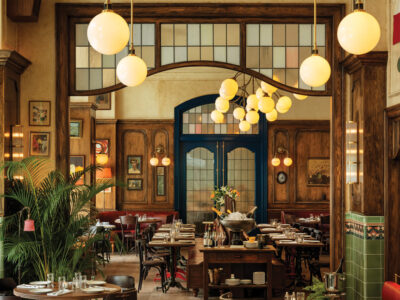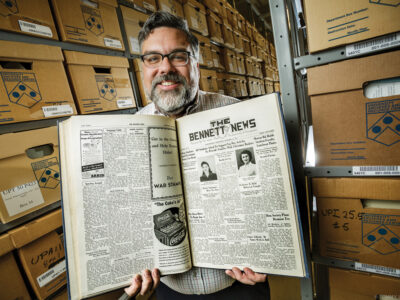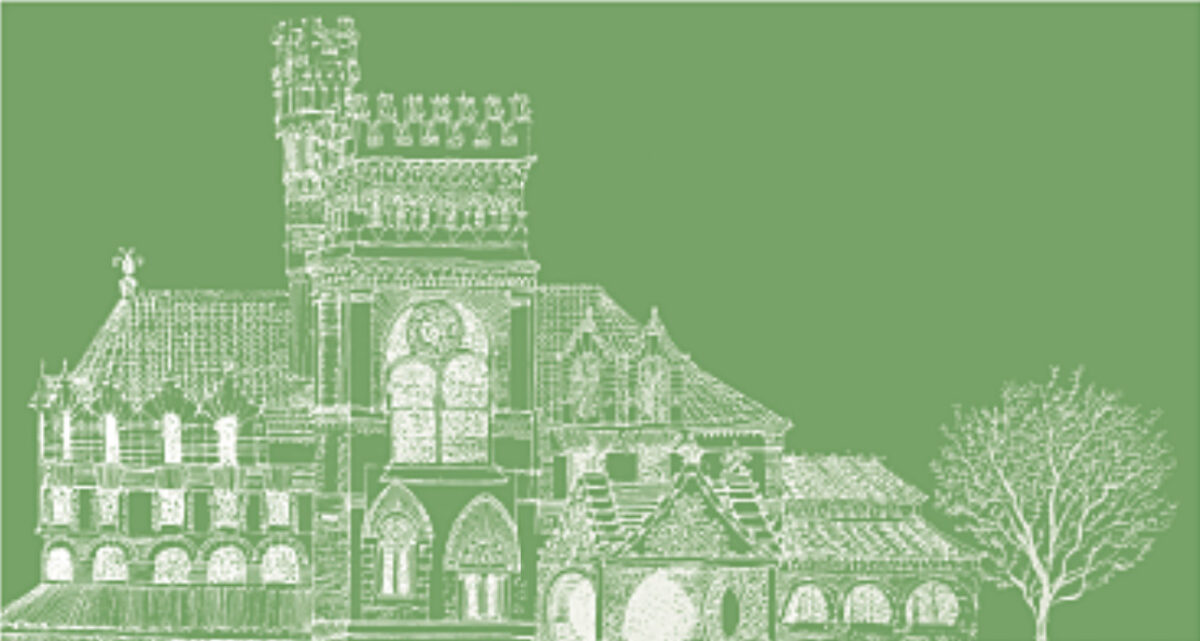
How the architecture of the campus—and the coverage it received in the Gazette—has reflected the University’s changing image of itself.
By George E. Thomas
As the 19th century entered its final decade, Philadelphia stood as the mightiest manufacturing center in the nation, and the University of Pennsylvania—relocated a quarter-century earlier across the Schuylkill River to West Philadelphia—was its training house and research laboratory. But in the mid-1890s a series of national and local events converged to transform the University’s central narrative from this utilitarian model to a collegiate ideal imitative of England’s Cambridge and Oxford universities, in which the University increasingly saw itself in competition with Eastern elite colleges like Princeton and Harvard.
In 1893, at the American Historical Conference in Chicago, Frederick Jackson Turner proclaimed the closing of the American frontier and the end of an era of social transformation made possible by the freedom that the frontier promised. Euro-culture and East Coast establishments moved to fill the void—represented most clearly by the triumph of classicism for the architecture of the Chicago Columbian Exposition where Turner gave his lecture.
Meanwhile, factory workers in Philadelphia accepted the devil’s bargain of scientific manager Frederick Winslow Taylor, taking higher wages in exchange for lessened work conditions —but in the process turned the nation toward the consumption culture of the present. In 1899, a Philadelphia-based advertising company, N. W. Ayer & Son, turned a biscuit into a phenomenon with its campaign for National Biscuit Company’s “UNEEDA” Biscuit. Over the next generation, Americans would learn to use media to shape identity and to create desire.
In the same decade, under a provost trained in the retail world, Penn repositioned itself from an important local university to one with national pretensions. This was symbolized by the simple act of re-dating its founding from 1749 to 1740 and by the complex one of reshaping its campus away from the free Victorian designs of buildings such as College Hall and Frank Furness’s University Library (now the Fisher Fine Arts Library) to the anglophile academic Gothic represented by Cope and Stewardson’s Quadrangle dormitories. Simultaneously, Penn transformed its old identity as workplace to the new leisure age with the construction of the nation’s first student union, Houston Hall, and the city’s first important athletic field, Franklin Field, where Penn’s juggernaut football team would play.
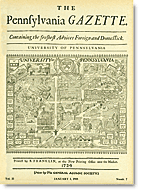
The story of this transformation was carried in new alumni publications aimed at enhancing Penn’s reputation and building loyalty among recent graduates, such as The Alumni Register(later The General Magazine and Historical Chronicle), published by the General Alumni Society starting in 1896; and Old Penn, founded as the official publication of the University in 1902, renamed The Pennsylvania Gazette in 1918, and published by the Alumni Society since 1925. The signal event was the debate over the founding date of the University that began in 1896 when The Alumni Register promoted the story that the University’s origins lay in George Whitefield’s Charity School that was ostensibly founded in 1740. Because this school was to be located in the church building later acquired by the board founded by Benjamin Franklin in 1749 to house his new Academy, it could be claimed as the beginning of the University.
Besides explaining the statue of the impassioned George Whitefield preaching that stands in the Quadrangle, this mergers-and-acquisitions model of institutional history had the desired effect of placing Penn ahead of Princeton in academic processions that in turn represented, in highly schematized form, the pecking order of American higher education. (The year before, in 1895, elite universities banded together to establish a national system of academic regalia that asserted an age- and class-based hierarchy and was most obviously expressed by placement in academic processions.)
With the 1740 date, instead of being number five or even six in the line of American higher education, Penn was fourth, following only Harvard (1636), William and Mary (1693 first fundraising, 1700 first classes), and Yale (1701), and ahead of Princeton (neé the College of New Jersey, 1744), and Columbia (originally New York’s King’s College, whose first college classes were held in 1754, antedating Penn’s by a year). In 1899, to settle the issue once and for all, Penn’s board of trustees passed a resolution declaring that henceforth, 1740 would be the official date of the founding of the University “because that was the date of the earliest of the many trusts the University has taken upon itself.”
Not coincidentally, this battle over Penn’s identity began when Penn’s leadership shifted from a scientist, William Pepper, M. D. (provost from 1881 to 1894) to a retailer of sugar, Charles Custis Harrison, who would serve from 1894 to 1910. Instead of celebrating the scientific and creative achievements of the laboratory and the classroom, Harrison’s marketers shifted Penn’s identity from the research arm of Philadelphia’s industrial culture to its place among the nation’s socially elite academic institutions. Ironically, while Penn was allying itself with the national elite culture, much that was innovative in Penn’s actual history was temporarily lost.
By redating Penn’s roots, the University obscured the connection to Franklin’s transforming vision that shaped American higher education, expressed in his Proposals for the Education of Youth in Pennsylvania, written in 1749. Lost as well was the significance of the University’s ethnically and religiously diverse student population, who were here in Philadelphia because of William Penn’s policy of religious toleration that set his commonwealth apart from other American colonies. By 1760, Franklin’s college and academy was drawing from other colonies and nations, differing from the monocultures of the New England colleges that typified college life in the American colonies.
Also uncelebrated was Franklin’s academy that was open to girls as well as boys, while the college was open to all males who could meet the academic requirements. German Peter Gabriel Muhlenberg C1763, the “fighting clergyman” who served as a brigadier general during the Revolution, was an early graduate; another was Moses Levy C1772, the nephew of Nathan Levy, who founded many of Philadelphia’s Jewish institutions. In 1802 Philadelphia’s and Penn’s continuing social openness was evident when Levy was elected to the board of trustees, where he served until 1826 as Penn’s last link to the Revolutionary generation. His story was also ignored in Penn’s magazines, in favor of inflated or spurious claims of connection to George Washington Hon1783 (in absentia), whose birthday was celebrated with historic and patriotic lectures for a century in the now-forgotten University Day, and Revolutionary War General Anthony Wayne, who in the 1930s was “discovered” to be an alumnus of the Class of 1765 on questionable evidence. Photographs of Wayne’s statue in Valley Forge appeared in the Gazette, with the implication that this was the image of manhood appropriate to Penn’s future.
The University’s 19th-century status as a center of engineering and its progressive role in educating those awarded city scholarships (granted in exchange for much of the land of Penn’s growing campus) were also dropped from the narrative. When collegiate prestige increasingly depended on exclusivity, inclusiveness was not a plus. A principal factor that led to the reshaping of Penn’s history was the growing rivalry with Princeton, Harvard, Yale, and Cornell, which was played out on the football field, in the design of the campus, and in aspects of campus life from rituals to songs. Penn’s anthem, “The Red and the Blue,” composed in 1896, places the origins of Penn’s colors in a combination of those of the best of her rivals. “Fair Harvard has her crimson, and Yale her colors too / But for dear Pennsylvania, we wear the Red and Blue.”
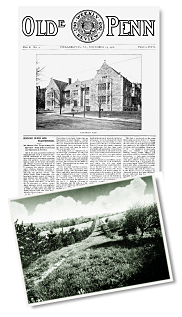
Meanwhile, the newly constructed dormitories, student union, and athletic field marked the metamorphosis of undergraduate life. In 1902, the first issue of Old Penn opened with a photograph of Houston Hall on its front page accompanied by an article on “College Clubs and Fraternities.” No more would college life at Penn be characterized by harsh, eye-straining work in the laboratory or library; instead, Old Penn reported a new and more enticing lifestyle:
The ancient idea, that the book worm is the highest product of scholastic or University training, has been displaced by the realization that the man best equipped for the conflict with modern world conditions, and most apt to be a credit and benefit to his Alma Mater, is the one whose development is many sided, if not entirely perfect.
Sports, music, theater, and other extracurricular activities took place in clubhouses, the gymnasium, and the new stadium that became the image of the turn-of-the century campus.
With University identity increasingly gauged against peer east-coast institutions Penn’s leaders commissioned Cope and Stewardson to design, in addition to the Quad dormitories, the Law School and a series of new classroom buildings in anglophile styles. They contrasted with Frank Furness’s library and the power plant and engineering-school building designed by the Wilson brothers (demolished in the 1920s for the construction of Irvine Auditorium) that were rooted in the functional expression of the region’s industrial culture.
To create an identity of appropriate antiquity on the English model, Penn’s new architects turned back the clock three and four centuries to buildings of the 14th and 15th centuries at Cambridge and Oxford. The new standard of genes instead of genius led Penn to advance its founding date and to shift its identity from engineering and the sciences, the programs in which more than half its students studied, to the anglophile elite culture of the East.
That the University was intentionally draping itself in the authority of English collegiate history by promoting an architectural continuity with Oxford and Cambridge was apparent in the way that the campus was depicted in Old Penn and the Gazette. Under the editorship of George Nitzsche L1898 (later the University’s publicity agent and recorder), Old Penn told the story of the campus and its growth so as to compare favorably with its Eastern rivals.
In its first year alone, stories praised the “magnificent” new law school building that proved that Penn was attracting students from around the nation. The paper reported with pride that the new gymnasium, Weightman Hall, was among the “most commodious in the United States and will be equipped with every modern convenience,” though it did not mention the industrial trusses that spanned its interior. And it weighed in on the importance of state appropriations for the growing School of Veterinary Medicine. However, even before the first year of publication had ended, the insidious focus on the past turned to fiction in an essay on “The Botanical Garden in May,” in the May 16, 1903 issue. Here Nitzsche certainly embellished and probably created history by claiming:
[T]he garden was a part of the great Governor Hamilton’s estate, whose stone mansion still stands in Woodland Cemetery. Along these walks, great statesmen passed with him in social or political converse. Here are trees planted for the trustees of the University of Pennsylvania, a weeping willow for Provost Harrison, a tulip poplar for Governor Pennypacker …
The scientific and progressive University that had developed under Dr. William Pepper’s provostship in the 1880s and revived the vision of Franklin had given way under Harrison to one that celebrated links to the pre-Revolutionary 18th century.
The success of Penn’s new identity as an ancient institution connected by design and desire to English antecedents and American peers was immediately apparent. When 1903 began, Old Penncould report that the year just ending had been the “most prosperous year [with] more money received by gift than ever before.” For the next half a century, Penn’s identity and its future would lie in architectural forms derived from the English past.
By the 1920s, despite the construction of the new Franklin Field and its enlargement with an upper deck a few years later, making it arguably the most perfect football stadium in the country, Penn suffered because its national image had never coalesced into a coherent identity. In some measure, this resulted from discontinuities that are the nature of an urban campus. Within the Quad or along Hamilton Walk between the Quad and the Botanical Garden, Penn’s imaginary world of Gothic quadrangles was consistent, but Woodland Avenue with its noisy trolleys and the industrial neighborhoods along the Schuylkill were only a few hundred feet away. Despite the extension of the Cope and Stewardson palette of materials west beyond 40th Street and east to 32nd Street, the central campus was still occupied by strange buildings of green serpentine stone and the even stranger library. Nothing, short of a massive takeover of the entire region with street closings to eliminate traffic, would ever give the campus the idyllic unity of Princeton or even nearby Haverford or Bryn Mawr. If Penn was to succeed on its chosen stage, more dramatic steps were needed.
With the national economic boom generating skyscrapers that marked American urban skylines with highly identifiable silhouettes, Penn once again began to rethink its physical appearance—and its West Philadelphia location—in favor of construction of an idyllic campus for the men’s college somewhere outside the city. With America’s Sesquicentennial to be staged in Philadelphia, no better site could have been found than the bucolic countryside at Valley Forge, where Washington’s Continental army had survived its horrific winter to be forged into an effective fighting weapon that gave the nation its freedom.
The idea of a Valley Forge campus was first raised at an alumni dinner in Wilmington in a talk by trustee George Wharton Pepper C1877 L1889 and then was vigorously championed by H. Mather Lippincott C1897, first in his role as editor of the General Magazine and Historical Chronicle, and later as editor of the Gazette, as well.
In one of many pieces on the subject, “The Problem of a College in the City,” Lippincott compared Penn to such WASP bastions as Amherst, Princeton, Dartmouth, and Williams. He concluded that Penn’s future was constrained by its urban site and early Victorian buildings, and that the right setting and the right socially elite students determined the worth of an institution.
In the 1890s, Penn presented itself as an institution taking part in making the modern world, and in its catalog the University took pride in its location in the midst of the greatest assemblage of industry in the world as a teaching tool where young would-be engineers could learn on site! The alumni now argued that a suburban setting would enable Penn to build a campus that would project an elite image to attract the type of students who would elevate Penn’s reputation—and, by extension, theirs.
While the General Magazine beat the drum for the new campus, the Gazette initially took a cautious stance on the Valley Forge story, largely because it remained the official University publication. In the March 4, 1927 issue, it reported evenhandedly on the reservations of the University of Minnesota’s Dean of College Administration, F. J. Kelly, who was commissioned by the trustees to evaluate the idea. Kelly raised serious questions about the costs and logistics of providing faculty and administration at two widely separated sites.
Undergraduates were polled as well. The editor of The Red and Blue, Philip S. Mumford C’24, wisecracked that the College told students to use the city, and “we’ve especially gone to theater [which would be] hard to do from [the] country.” Despite these difficulties, the Valley Forge idea took on a life of its own. University committees were established to explore design possibilities. The chosen architects, H. Brognard Okie C1897 and G. Edwin Brumbaugh Ar’13, proposed a revival of the local colonial style to build on the national identity of Valley Forge.
In 1925, the Gazette was turned over to the Alumni Society to unify alumni communications. Over time, especially after Lippincott was named editor in 1931 in a Depression-inspired consolidation, it too joined the battle for a country setting for the College in Valley Forge on land of its own purchase, where Penn would be free from the onerous requirement to accept those other people who wouldn’t be accepted at Harvard, Princeton, Dartmouth, and Amherst.
In December 1929 (two months after the stock market crash), the Gazette reported that the trustees had accepted Henry Woolman’s offer of a 175-acre farm at Valley Forge as the site of the new men’s college. As the Depression deepened, there were difficulties on campus that augured poorly for Valley Forge. An article on the University assets in the December 16, 1930 issue of the Gazette reported a net value of nearly $50 million with only $18 million in endowments. Worse, of Penn’s $3.1 million budget, $2.6 million came from fees and only $500,000 was derived from endowment investments. Nonetheless, in the January 16, 1931 issue, it was announced that George W. Pepper had been made chairman of the committee for Valley Forge and the University affirmed the use of the Valley Forge property for the College.
While the Valley Forge story carried the headlines, the Depression largely eliminated campus expansion in West Philadelphia. The most important building project was Robert Rhodes McGoodwin’s scheme to clad Frank Furness’s by-then disliked University Library in academic Gothic on the order of Irvine Auditorium. Work began in 1932 with the Horace Howard Furness wing. Fortunately, the ever-deepening Depression stopped work with the first phase, making it later possible to restore Furness’s masterpiece under the direction of Venturi, Scott Brown and Associates and the Clio Group, Inc. in 1991.
The 1930s ended with a burst of fundraising and historical fervor aimed at celebrating the University’s putative 200th birthday in 1940 on the national stage. Among the gifts was one from the Houston family that made it possible to enlarge Houston Hall to meet the needs of the significantly enlarged student body. Still undeterred, the Gazette emphasized the Valley Forge campus with the announcement of a special campaign for its development.
The campus narrative was subsumed in the global catastrophe of World War II, which had the positive effect of pushing Penn kicking and screaming into the modern world. A General Electric advertisement in the October 1940 issue of the Gazette showed an ocean-going freighter offloading an immense crate labeled “Freedom-Made in the U.S.A.” The same issue included a story about Penn becoming a part of the military war-research effort, a shift of focus that would forever change the University. Six years later, one of the fruits of that work, the Moore School’s ENIAC, the first electronic computer, would make its first calculation and become a part of a much larger shift toward research, much of it federally sponsored, as a means of sustaining the University.
After World War II, the G. I. Bill broadened Penn’s student body, much as the city land-grant scholarships had done half a century before. But it also introduced a new problem—21 percent of the undergraduates were married, making it necessary to find off-campus apartments for them, according to the October 1946 issue. Another problem that has not gone away appeared—for the first time, the local streets could not handle the parking needs of students and faculty who had grown used to the convenience of the car during the war. And with a level of distress that only an academic could understand, it was reported that favorite diners were filled by 12:30, making lunch difficult.
Bigger changes were coming. In 1948, the trustees looked outside of their immediate circle to choose former Minnesota governor Harold Stassen Hon’48 as president of the University. He immediately commissioned a group of Penn alumni to produce a master-plan for expansion of the historic campus that was the subject of extensive discussion in the Gazette. Valley Forge was not mentioned. “Expansion Plans Revealed” in December 1948 told of a new vision for the West Philadelphia campus that would add 35 acres of land to the 113 already occupied by the University. Of greatest significance was the proposal to close a number of streets, including the diagonal of Woodland Avenue that cut through the campus. Five buildings would be constructed in a simplified Beaux Arts style, a library to replace Furness’s 1890 building, a new Wharton School (Dietrich Hall), a new physics laboratory (Rittenhouse Laboratories), and new buildings at the hospital. The centerpiece would be a skyscraper for the administration at the intersection of 36th and Locust Streets that would provide visual evidence of renewal at Penn. Each would be designed in “the traditional style to preserve the atmosphere of the University,” the Gazette noted. “Red brick and limestone will be used for exteriors.” Much of the animus of the plan was aimed at demolishing the hated Victorian structures, particularly the old library, Logan Hall, and the Hare Building (which was demolished to build Williams Hall). Only College Hall would have remained standing from the first phase of campus development in West Philadelphia.
Another break in Penn’s allegiance to its past was made when Stassen hired Harvard-trained G. Holmes Perkins Hon’72 as the new dean of the School of Fine Arts and placed him in charge of campus development. After Stassen’s departure in 1952, Perkins worked in concert with a new president, former physics professor Gaylord P. Harnwell Hon’53, turning the campus toward contemporary architecture and an active involvement with the modern world that paralleled Penn’s move to join the Ivy League for its athletic affiliation. Once again Penn’s identity was transformed.
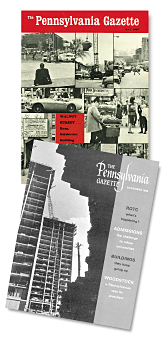
In January 1961 the Gazette published accounts of Penn’s first long-range plan that was commissioned by Harnwell to help assess the University’s needs. The new campus of the information-age University would be built around laboratories and residences rather than football and amusements. The 1890s image of big-time football, social clubs, and gentleman’s Cs was replaced by the shared academic values of the Ivy League. Given the current campaign to improve Penn’s neighborhood and attract faculty to live nearby, the final point of Harnwell’s plan resonates with the present, for it too sought to “ameliorate some features of [Penn’s urban] environment.” The provision of a “congenial residential neighborhood,” the plan added, “will go far in encouraging the residence of a larger fraction of the faculty in the neighborhood of the campus.”
Under another scientist as its president, the University had returned to the values of Franklin and Provost Pepper. The results were soon seen across the campus. Instead of the stodgy designs of the Stassen era that gave Penn such unmemorable buildings as Van Pelt Library, Rittenhouse Laboratory, and Dietrich Hall (concealed and renamed Steinberg-Dietrich Hall in the 1980s), Perkins under Harnwell hired important contemporary designers for central buildings. Typically they were chosen from a pool of Penn graduates—Louis I. Kahn Ar’24 Hon’71 had graduated in the 1920s and was the Cret Professor of Design in Perkins’ faculty. Ehrmann Mitchell Ar’48 and Romaldo Giurgola (faculty 1954-66) designed the structurally innovative garage at 33rd and Walnut Streets, while Robert Geddes and Melvin Brecher served on the faculty and added Warren Cunningham Ar’49 to their number to receive the commission for the Moore School Addition, now called Pender Laboratory. In the case of Eero Saarinen, architect for the women’s dormitory, Hill Hall, Perkins got around the requirement that the architect be a Penn graduate by demonstrating that Penn graduates worked in Saarinen’s office.
In February 1961, the Gazette reprinted a press conference given by Saarinen in which a reporter asked if there wasn’t something akin to harshness about the new women’s dormitory, Hill Hall, adding that it wasn’t “pink and puffy.” Saarinen agreed, noting that pink was no longer the image of modern women. Instead, he had tried to design in “continuity with other buildings because that seems to be the character of the University of Pennsylvania.” By returning to its roots as Franklin’s institution, with new architecture representing a commitment to contemporary issues and old buildings representing its century in West Philadelphia, Penn’s identity was finally consistent with its history. Penn’s brand as a modern institution was beginning to emerge.
But nothing is that easy at Penn. When Martin Meyerson Hon’70 took over as president in 1970, Harnwell had spent the University to the brink of insolvency. With the energy crisis and rampant inflation dogging his tenure, Meyerson, an urban planner, was forced to rein in the very projects for which he had been brought to Penn to oversee.
In 1981, the trustees selected a new president, historian Sheldon Hackney Hon’93, who would lead the University into the 1990s. By this time, Penn’s first West Philadelphia buildings were in a state of decay, reflecting the not-so-benign neglect of what was euphemistically termed “deferred maintenance.” Though women had been fully integrated into the campus in 1970, even being housed in the most sacred of male precincts, the Quad (until then known as the “Men’s Dorm”), they had lost their own special areas, such as Bennett Hall, and new space had not been found for them on the main campus—especially on Locust Walk, which was still almost entirely devoted to fraternities.
The role of fraternities on campus had been debated in the Gazettesince the beginning of the Harnwell presidency. By the 1980s, several fraternities had run afoul of the law, leading to a study of their campus presence led by History Professor C. Drew Faust. This resulted in the “Faust Report,” which the Gazette reported on in the November 1990 issue, that called for a more pluralist community at Penn. The debate continues to the present but the adaptation of three former fraternity structures between 36th and 37th streets to other University uses—including a center for Penn women in Locust House, a new graduate-student center, and the Penn Humanities Forum—suggest that the tide is running against an all-male precinct and perhaps against fraternities as well.
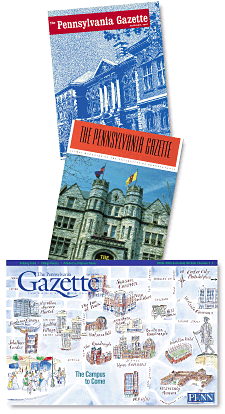
With a fattened University budget supported by donors riding the Reagan economic boom, the University began building again. Led by trustee Paul F. Miller Jr. W’50 Hon’81, Penn began a campaign for $1 billion that was raised with relative ease. In the Gazette, articles celebrated “The House that Lauder Built,” “The ICA’s New Home,” and other projects. A more remarkable shift occurred during the Hackney presidency—a renewed interest in Penn’s historic buildings dating from before the Harrison re-imaging of the campus. Instead of being demolished, the once-hated, now-beloved Victorian buildings were restored, including the Furness Building (which won the President’s Award from the Advisory Council for Historic Preservation, the nation’s highest honor for preservation), College Hall, and Logan Hall. Restored, they emphasize Penn’s continuity on its West Philadelphia campus for more than half of its existence.
The University may even have come to terms with its founder and founding date. When an incredibly condensed University history was written by the author for the limestone stele ornamenting the Perelman Quadrangle—as a part of the Venturi, Scott Brown and Associates restoration and rehabilitation of the historic core of the Penn campus, completed in 2000—the 1749 date at the top of one was accepted without question (though 1740 is still cited as the University’s founding, albeit in smaller type).
Under another scientist, Dr. Judith Rodin CW’66, inaugurated in 1994—a century to the year after Harrison’s term began—Penn had finally become comfortable with its identity. In large measure this was because Penn’s identity as a national and global research and teaching community had coalesced with the exuberant life of the campus. Instead of seeking to represent a male monoculture of Anglo-wannabes, the campus’s splendid variety of buildings celebrated the evolution of contemporary life—from the Centennial era of a nation rebuilding itself to the gaudy present in all of its rich variety. As such, it matched Franklin’s original vision as a place where the useful and the ornamental could be studied and where the modern world could be embraced. Penn had finally built a brand that resonated with its entire community while reaching out globally. Franklin would be proud indeed of his creation.
George E. Thomas Gr’75 is an instructor in historic preservation and urban studies at Penn. He co-authored, with David Brownlee, Building America’s First University, and is also the author of The Campus Guide: University of Pennsylvania, among other books.


